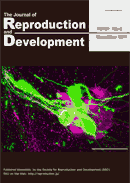Volume 53, Issue 5
October
Displaying 1-20 of 20 articles from this issue
- |<
- <
- 1
- >
- >|
Review
-
2007Volume 53Issue 5 Pages 977-986
Published: 2007
Released on J-STAGE: October 31, 2007
Download PDF (212K)
Full Paper
-
2007Volume 53Issue 5 Pages 987-993
Published: 2007
Released on J-STAGE: October 31, 2007
Advance online publication: August 08, 2007Download PDF (145K) -
2007Volume 53Issue 5 Pages 995-1005
Published: 2007
Released on J-STAGE: October 31, 2007
Advance online publication: June 22, 2007Download PDF (355K) -
2007Volume 53Issue 5 Pages 1007-1013
Published: 2007
Released on J-STAGE: October 31, 2007
Advance online publication: June 08, 2007Download PDF (246K) -
2007Volume 53Issue 5 Pages 1015-1021
Published: 2007
Released on J-STAGE: October 31, 2007
Advance online publication: June 08, 2007Download PDF (139K) -
2007Volume 53Issue 5 Pages 1023-1034
Published: 2007
Released on J-STAGE: October 31, 2007
Advance online publication: June 22, 2007Download PDF (270K) -
2007Volume 53Issue 5 Pages 1035-1041
Published: 2007
Released on J-STAGE: October 31, 2007
Advance online publication: June 08, 2007Download PDF (348K) -
2007Volume 53Issue 5 Pages 1043-1052
Published: 2007
Released on J-STAGE: October 31, 2007
Advance online publication: June 25, 2007Download PDF (333K) -
2007Volume 53Issue 5 Pages 1053-1058
Published: 2007
Released on J-STAGE: October 31, 2007
Advance online publication: June 25, 2007Download PDF (168K) -
2007Volume 53Issue 5 Pages 1059-1068
Published: 2007
Released on J-STAGE: October 31, 2007
Advance online publication: June 29, 2007Download PDF (253K) -
2007Volume 53Issue 5 Pages 1069-1078
Published: 2007
Released on J-STAGE: October 31, 2007
Advance online publication: July 06, 2007Download PDF (249K) -
2007Volume 53Issue 5 Pages 1079-1086
Published: 2007
Released on J-STAGE: October 31, 2007
Advance online publication: July 06, 2007Download PDF (252K)
Research Note
-
2007Volume 53Issue 5 Pages 1087-1091
Published: 2007
Released on J-STAGE: October 31, 2007
Advance online publication: June 25, 2007Download PDF (120K) -
Immunolocalization of Steroidogenic Enzymes in Equine Fetal Adrenal Glands During Mid-Late Gestation2007Volume 53Issue 5 Pages 1093-1098
Published: 2007
Released on J-STAGE: October 31, 2007
Advance online publication: June 22, 2007Download PDF (223K) -
2007Volume 53Issue 5 Pages 1099-1105
Published: 2007
Released on J-STAGE: October 31, 2007
Advance online publication: June 25, 2007Download PDF (163K) -
2007Volume 53Issue 5 Pages 1107-1112
Published: 2007
Released on J-STAGE: October 31, 2007
Advance online publication: June 22, 2007Download PDF (125K) -
2007Volume 53Issue 5 Pages 1113-1118
Published: 2007
Released on J-STAGE: October 31, 2007
Advance online publication: June 29, 2007Download PDF (208K) -
2007Volume 53Issue 5 Pages 1119-1124
Published: 2007
Released on J-STAGE: October 31, 2007
Advance online publication: July 06, 2007Download PDF (244K) -
2007Volume 53Issue 5 Pages 1125-1130
Published: 2007
Released on J-STAGE: October 31, 2007
Advance online publication: July 06, 2007Download PDF (226K) -
2007Volume 53Issue 5 Pages 1131-1136
Published: 2007
Released on J-STAGE: October 31, 2007
Advance online publication: July 23, 2007Download PDF (229K)
- |<
- <
- 1
- >
- >|
